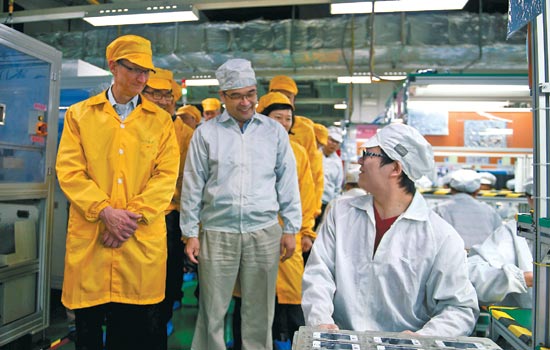Homeward bound? Firms mull return
Updated: 2012-07-23 09:28
By Shen Jingting, Chen Limin and Tuo Yannan (China Daily)
|
||||||||
|
 |
|
Tim Cook (left), chief executive officer of Apple Inc, visiting the iPhone production line at the Foxconn Technology Group facility in Zhengzhou, in Central China's Henan province. Apple Inc now outsources most of its manufacturing to Taiwan-based Foxconn. [Photo/China Daily] |
Rising labor costs and cheaper US energy drive some companies back
It has taken 25 years to evolve from the brick-like dageda (big brother's handset) to the slim iPhone currently in vogue.
The first mobile phone, the Motorola 3200, entered the Chinese market in 1987 and marked the start of a craze that now sees them in nearly everyone's possession.
|
||||
It is similar for other electronic products that first made their way to China from foreign companies and then began to be produced here en masse because of the country's huge and relatively cheap labor.
Soon the Middle Kingdom became the global manufacturing center after Japan. A random search of electronic products on a retailer's shelves now inevitably reveals "Made-in-China" labels or, at least, components produced in the country.
Now, however, some overseas companies are considering moving their manufacturing facilities out of China.
Heading home?
When US President Barack Obama joined Silicon Valley's top luminaries for dinner in California in early 2011, he asked the late Steve Jobs, the founder of Apple Inc, what it would take to start assembling iPhones in the United States.
Jobs' answer was quite straightforward and might have disappointed Obama. "Those jobs aren't coming back," he said, according to another dinner guest. However, one year on and after Jobs' death last year, Tim Cook, his successor as Apple's chief executive officer, gave Obama a more positive reply.
Cook said in a May interview in Rancho Palo Verdes, California, that he wanted the cellphones to be manufactured in the US. Although it would not be easy to achieve the goal, it was a clear hint that it may come to pass. And it fitted in with Obama's call for corporate America to reduce manufacturing outsourcing overseas, especially to China.
Some US companies have been on the move. The Michigan-based Whirlpool Corp, the world's No 1 home appliance maker with sales of $19 billion last year, brought back production of its KitchenAid hand mixers to the US. For the previous six years, a contractor in Huizhou, South China's Guangdong province, made them.
Company Chairman and Chief Executive Officer Jeff Fettig said in order to fulfill the company's commitment to produce in the US and cater to local customers' needs, Whirlpool decided to move some product lines back to the US.
The shift created a net gain of about 25 job opportunities in the US, the Wall Street Journal reported. In contrast to Whirlpool's total 68,000 employees across the world, the figure is tiny.
General Electric Co plans to invest $1 billion by 2014 to upgrade product lines and create new factories for items not previously made in the US. The company is about to add hundreds of employees to its sprawling Appliance Park operations in Louisville, Kentucky, this year.
Similar moves by Otis Elevator Co, Caterpillar Inc and Ford Motor Co, have created a few thousand more positions in the US.
The examples above may be just a beginning. According to findings by the Boston Consulting Group, more than a third of US-based manufacturing executives at companies with sales greater than $1 billion are planning to bring back production to the US from China - or are considering it.

 Relief reaches isolated village
Relief reaches isolated village
 Rainfall poses new threats to quake-hit region
Rainfall poses new threats to quake-hit region
 Funerals begin for Boston bombing victims
Funerals begin for Boston bombing victims
 Quake takeaway from China's Air Force
Quake takeaway from China's Air Force
 Obama celebrates young inventors at science fair
Obama celebrates young inventors at science fair
 Earth Day marked around the world
Earth Day marked around the world
 Volunteer team helping students find sense of normalcy
Volunteer team helping students find sense of normalcy
 Ethnic groups quick to join rescue efforts
Ethnic groups quick to join rescue efforts
Most Viewed
Editor's Picks

|

|

|

|

|

|
Today's Top News
Health new priority for quake zone
Xi meets US top military officer
Japan's boats driven out of Diaoyu
China mulls online shopping legislation
Bird flu death toll rises to 22
Putin appoints new ambassador to China
Japanese ships blocked from Diaoyu Islands
Inspired by Guan, more Chinese pick up golf
US Weekly

|

|








